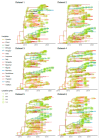Not Asian Anymore: Reconstruction of the History, Evolution, and Dispersal of the "Asian" Lineage of CPV-2c
- PMID: 37766368
- PMCID: PMC10535194
- DOI: 10.3390/v15091962
Not Asian Anymore: Reconstruction of the History, Evolution, and Dispersal of the "Asian" Lineage of CPV-2c
Abstract
Variability has been one of the hallmarks of canine parvovirus type 2 (CPV-2) since its discovery, and several lineages and antigenic variants have emerged. Among these, a group of viruses commonly called Asian CPV-2c has recently been reported with increasing frequency in different regions. Currently, its global epidemiology and evolution are essentially unknown. The present work deals with this information gap by evaluating, via sequence, phylodynamic, and phylogeographic analyses, all the complete coding sequences of strains classified as Asian CPV-2c based on a combination of amino acid markers and phylogenetic analysis. After its estimated origin around 2008, this lineage circulated undetected in Asia until approximately 2012, when an expansion in viral population size and geographical distribution occurred, involving Africa, Europe, and North America. Asia was predicted to be the main nucleus of viral dispersal, leading to multiple introduction events in other continents/countries, where infection establishment, persistence, and rapid evolution occurred. Although the dog is the main host, other non-canine species were also involved, demonstrating the host plasticity of this lineage. Finally, although most of the strains showed an amino acid motif considered characteristic of this lineage, several exceptions were observed, potentially due to convergent evolution or reversion phenomena.
Keywords: CPV-2; Protoparvovirus carnivoran1; canine parvovirus type 2; molecular epidemiology; parvovirus; virus evolution.
Conflict of interest statement
The authors declare no conflict of interest.
Figures






Similar articles
-
Analysis of canine parvoviruses circulating in Australia reveals predominance of variant 2b and identifies feline parvovirus-like mutations in the capsid proteins.Transbound Emerg Dis. 2021 Mar;68(2):656-666. doi: 10.1111/tbed.13727. Epub 2020 Jul 29. Transbound Emerg Dis. 2021. PMID: 32657506
-
Genetic characterization of canine parvovirus type 2c from domestic dogs in Korea.Transbound Emerg Dis. 2020 Jul;67(4):1645-1653. doi: 10.1111/tbed.13501. Epub 2020 Mar 1. Transbound Emerg Dis. 2020. PMID: 32009300 Free PMC article.
-
Spreading of canine parvovirus type 2c mutants of Asian origin in southern Italy.Transbound Emerg Dis. 2019 Nov;66(6):2297-2304. doi: 10.1111/tbed.13283. Epub 2019 Jul 14. Transbound Emerg Dis. 2019. PMID: 31254456 Free PMC article.
-
[Origin and evolution of canine parvovirus--a review].Wei Sheng Wu Xue Bao. 2011 Jul;51(7):869-75. Wei Sheng Wu Xue Bao. 2011. PMID: 22043787 Review. Chinese.
-
Canine parvovirus: the worldwide occurrence of antigenic variants.J Gen Virol. 2016 Sep;97(9):2043-2057. doi: 10.1099/jgv.0.000540. Epub 2016 Jul 7. J Gen Virol. 2016. PMID: 27389721 Review.
Cited by
-
The first evidence of Asian-like CPV-2b in Slovakia in a vaccinated dog with an acute fatal course of parvovirus infection: a case report.Vet Res Commun. 2024 Oct;48(5):3253-3262. doi: 10.1007/s11259-024-10492-z. Epub 2024 Aug 9. Vet Res Commun. 2024. PMID: 39120673 Free PMC article.
-
Canine parvovirus in North-East India: a phylogenetic and evolutionary analysis.Vet Q. 2024 Dec;44(1):1-13. doi: 10.1080/01652176.2024.2408742. Epub 2024 Oct 1. Vet Q. 2024. PMID: 39350725 Free PMC article.
-
Introduction of a Divergent Canine Parvovirus Type 2b Strain with a Dog in Sicily, Southern Italy, Through the Mediterranean Sea Route to Europe.Pathogens. 2025 Jan 23;14(2):108. doi: 10.3390/pathogens14020108. Pathogens. 2025. PMID: 40005485 Free PMC article.
-
Molecular epidemiology of canine parvovirus type 2 in Sicily, southern Italy: A geographical island, an epidemiological continuum.Heliyon. 2024 Feb 17;10(4):e26561. doi: 10.1016/j.heliyon.2024.e26561. eCollection 2024 Feb 29. Heliyon. 2024. PMID: 38420403 Free PMC article.
-
Epidemiological status and genome characteristics of canine parvovirus in China from 2022 to 2024.Arch Virol. 2025 May 11;170(6):124. doi: 10.1007/s00705-025-06301-w. Arch Virol. 2025. PMID: 40350501
References
MeSH terms
LinkOut - more resources
Full Text Sources
Miscellaneous

